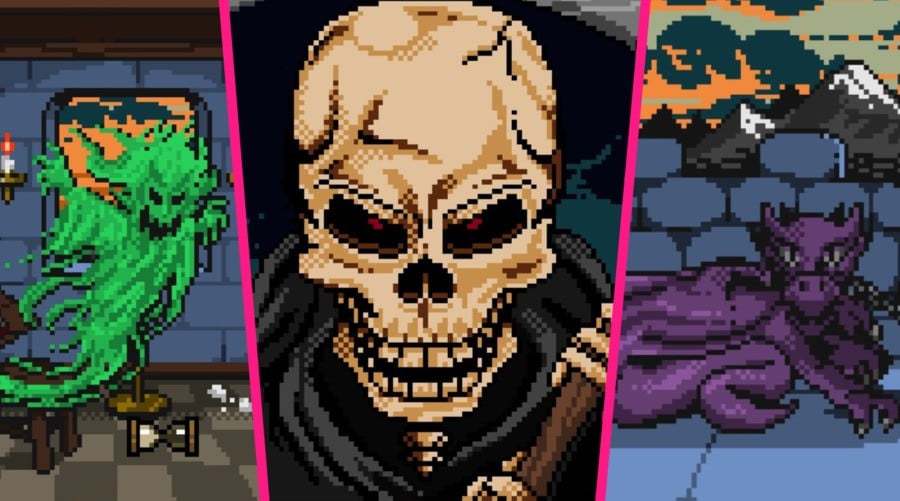
If you grew up with a fondness for point-and-click adventures, you may remember Shadowgate. Originally released as part of ICOM Simulations' Macventure series of adventure titles for the Apple Macintosh in 1987, the game saw players take control of a young hero who had been transported to the gates of Castle Shadowgate and entrusted with the task of solving a series of difficult puzzles to defeat the evil Warlock Lord.
As many of you who have played the game will no doubt recall, the route through the game's titular castle was fraught with danger, containing various fun, inventive, frustrating, and hilarious ways to die. These included everything from activating trap doors to getting eaten by sharks or having your body disintegrate inside the form of a gelatinous cube. With each of these deaths, the visage of the Grim Reaper would appear on screen, taunting the player for their failure and allowing them time to process what had just happened.
After the game's initial release, it was eventually ported over to a bunch of other machines, with Kemco's version for the NES proving to be particularly popular with players. So, as a result, a design document for a sequel to Shadowgate NES was eventually drawn up, under the title Beyond Shadowgate, but ended up being put aside after being completed, with only a few elements later finding their way into the 1993 Turbografx-16 title of the same name.
In a shocking turn of events, however, that nobody could have anticipated, Zojoi (a company founded by the Shadowgate co-creators Dave Marsh and Karl Roelofs) and an indie studio named Grahfmetal recently banded together to bring this 34-year-old design doc to life as a new PC game — doing so with the help of almost 2000 Kickstarter backers. We reached out to Marsh to find out more about this miraculous revival, but couldn't resist asking him a few questions about the history of the series first, which he was kind enough to answer for us.
The History of Shadowgate
Time Extension: Let's go all the way back to the beginning of Shadowgate. How did you originally get involved with the Macventure series at ICOM? Could you tell us more?
Marsh: So the reason I got the job was I was working in a youth ministry at this church and this guy came in and he was a programmer. His name was Terry Schulenburg and he was working on — I think he may have been working on The Uninvited at that point. And I had, maybe, a RadioShack TRS-80 or something when I was a kid, and all I did was move pixels around on the screen, right? So I think the grid was probably 16 pixels wide by 8 pixels tall, and you had 6 or 8 colors to work with, and you had a joystick. So you'd just move the pixels up and down. So I made spaceships and robots and other things. But I was really interested in pixel art in general.
So when I met him, I was talking to him about that. And the Mac, of course, had just come out in 1984. And of course, it was black and white pixels. So he lent me a Mac and said, 'My company said if you want to go ahead and try something and try to create a game, go ahead.' And I grew up in Chicago or outside of Chicago. And just across the border was Lake Geneva, Wisconsin, which was the birthplace of Dungeons & Dragons. So my mom would drive me and my friend there and we would go to this place called the Dungeon Store which sold player handbooks and monster manuals and Gary Gygax would be there. They also sold lead miniatures and things like that.
So anyway, I was a huge D&D player and D&D fan, so I thought, 'Well, this would be really fun.' So my friend Karl Roelofs and I got together — I was still living in my parent's house — and we would sit in my bedroom and design rooms. We had this Mac and it had an internal floppy drive and we would pull out the system disk and shove in the MacPaint disk, continue to do that, and then save. It's crazy, right? So we didn't really know what we were doing with Shadowgate. We were just trying to come up with puzzles that we thought were interesting.
Then ICOM gave us jobs. We put it to the side for a while because I was working on The Uninvited for a bit. And then we eventually finished Shadowgate in 1987. Yeah, so that's how I got involved.
Time Extension: You mention you were well-positioned to sort of go to this store in Wisconsin and buy game books and other things like that. Was there anything in particular that inspired you on the original Shadowgate in terms of specific versions of D&D or anything like that?
Marsh: Yeah, hold on a second. I'll go grab that. So, I just got this signed by the artist, but I think this is from the DM guide. It's either that or the player's handbook. That single image inspired Shadowgate. It's a guy that's trying to get out of a room that's flooding. Obviously, he did a trap and then there's a skeleton coming out of the water that's going to kill him.
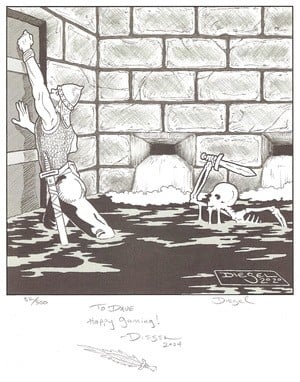
I had been obsessed with that image as a kid. And I love that idea. I mean, the whole idea of D&D that I love was the fact that our dungeon master, a guy named Dave Wolff, used to have rooms that weren't 'Okay, we're walking into a dungeon room', and then 'Okay, we're walking into the next dungeon room'. His rooms were always very different.
So when you play Shadowgate, you're probably like, 'Why is there a lava room right next to this water room right next to this?' And it's only because I was too impatient and I loved the variety of how Dave ran his campaigns. And so that's why Shadowgate is how it is. Because that's how we used to play D&D: every room is different. And then, there was always some problem there. There was always some puzzle. There was always some trap. There was always something. So when I saw this image in the book it just and my friend Terry Schulenburg said, 'Well, why don't you try to make a game?' I always referred back to that.
Time Extension: One of the things that we loved about the original Shadowgate was the wide array of funny and interesting ways you can die. We're wondering if you could talk a little about the origin of those deaths and how those originally came about.
Marsh: So the thing with Shadowgate is that we knew that the player was going to be able to do all this stuff. They were going to be able to use a torch on themselves, right? Or, you know use self on window — all those different things. And I don't want this to sound trite but I didn't want to promote suicide. I was like 22 or something and so I didn't want to do that. So I wanted to make every kind of death sound either kind of funny or just like painfully stupid or whatever.
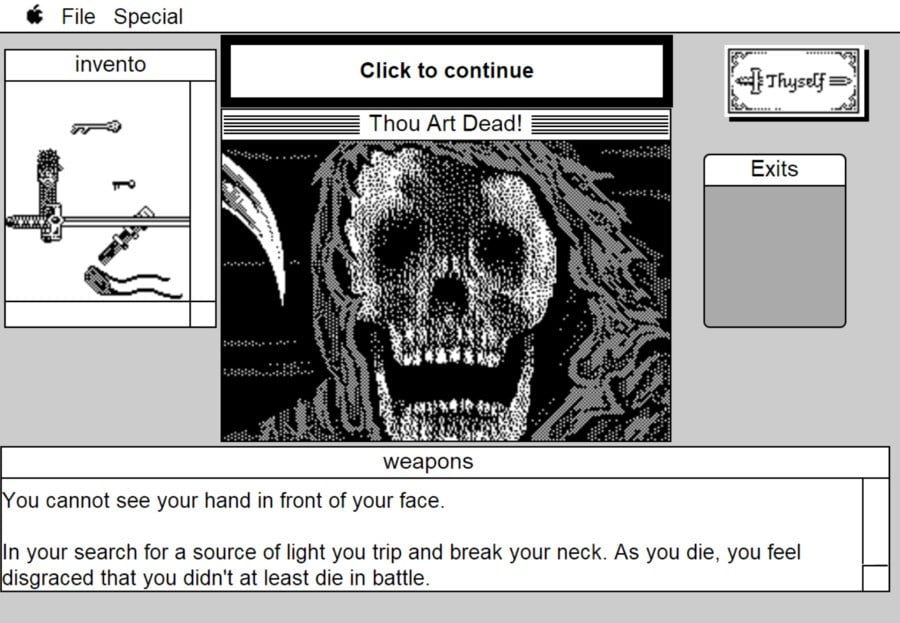
Time Extension: In terms of the various ports of Shadowgate — what was your familiarity with what was going on with Shadowgate after it was released in terms of, say, the NES version? Did you consult at all on that or were you involved at all?
Marsh: So, after every Macventure was released, whether it was Déjà Vu or Déjà Vu 2 or The Uninvited or Shadowgate, Karl and I spent half of our time porting the artwork and the other half designing a new game. And so, in the case of Shadowgate, we would port the game to the Apple II, Commodore 64, Atari ST, Commodore Amiga, and PC in various color formats and stuff. So this was kind of going on and at the same time, we were developing Beyond Shadowgate for the black and white Mac. And so what had happened is Kemco, the Japanese company, came to ICOM and said, 'We want to port this to NES.' And we said, 'You can't port this to NES. It's a Windows-based thing. It would be too much of a pain. You can't do it.'
Anyway, they said, 'No, no, no. We really want to do it. Let us do a prototype and show it to you.' So we eventually said, 'Okay'. Then it came in and it looked really good. We're really surprised at how they used it. So they just told us, 'We think we can get this on a cartridge, we're going to do it all sprite-based. We think this will be something cool. We'll take all your text, and we're going to convert it to Japanese for the Japanese market. And then we're going to reconvert it into English'.
So that ended up being kind of hilarious in its own way, right? Because some of the things that were converted and converted back. Like originally, it would say, 'You can't do that' when you try to combine two objects, but here it would say, 'You pulled a boner.' So that was just basically, 'Hey, you've made a silly mistake'.
So Karl and I were assigned to it and we would review the ROMs and we would playtest it, and make comments about the English and stuff. And then that's pretty much where we were done. They basically licensed the game and then we just went and did some quality assurance on it.
Time Extension: If possible, we'd love to talk about this follow-up. The whole thing with this new project obviously started because there was a design document that you made after finishing the original Shadowgate. Could you talk about why it didn't get made back then? We believe you mentioned in the Kickstarter video that they started to focus more on licensed properties. Is that the specific reason?
Marsh: Basically, the market was changing. Our company had gotten bigger, and it was difficult to make money on just the Macventures. So we started picking up some other work. And, at that time, or right around that time, we built a relationship with a company called Sunsoft, and Sunsoft was making SNES games, so that became the next big shiny object for our CEO. And so we said, 'Okay. Well, let's do that' and Sunsoft had picked up the Warner Brothers license for Looney Tunes. So, basically, from that point I was designing Road Runner's Death Valley Rally and other things. So we just had moved away from Macventures and we were entering that market.
After that, we got into Full Motion Video (FMV), which was the Sherlock Holmes Consulting Detective stuff, and Dracula Unleashed. And then we were doing some work for this new machine called the TurboGrafx-16, which was a great gaming machine, but with terrible titles. So, we worked on a number of things for that. In fact, I think Beyond Shadowgate ended up going to that as a side-scrolling adventure.
Time Extension: Yeah, we wanted to ask you about that. What is your opinion on the TurboGrafx-16 Beyond Shadowgate and that shift in perspective from first-person to third-person?
Marsh: Yeah, I didn't really have any involvement in it. Another team was doing it within the company and that was fine. My guess is at that time I wasn't too happy about it. I was glad to see that they were doing something. It was very, very, very loosely based on the design document that Karl and I had written. And so, the fact that it was even going out there was something.
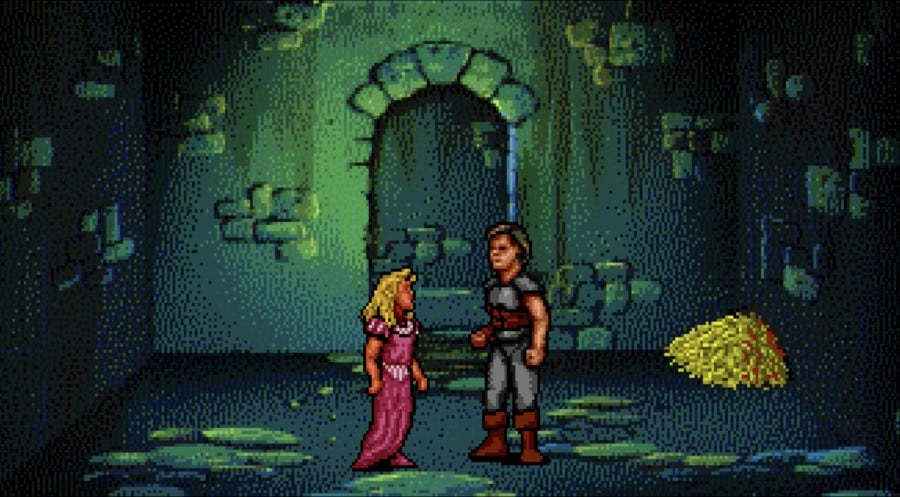
But there was no player base for that. It wasn't like we were putting it out on any sort of Nintendo System, right, where players said, 'Hey, I played Shadowgate on NES, and now I'm playing this game.' And again, that machine was ill-marketed. I mean, it had a freaking CD player in it. CD players at that time cost a thousand dollars in the US to buy one but here for you know 250 bucks or whatever you could have your own CD player. You could play music on it, but they never advertised that.
So, to answer your question, I really don't have a whole lot of memory of that. I was very, very busy on other projects and mostly projects I didn't care about. I mean really what I wanted to do was make adventure games. Road Runner's Death Valley Rally was a blast because I loved Road Runner as a kid. But then the projects I had to work on for NES and the Turbografx were no fun. And then we got bought by Viacom, and it was kind of all downhill from there. So, again, I don't have a lot to do with that version of Beyond Shadowgate. But, for some reason, I kept this massive design document in my basement for 30 years.
Time Extension: Did you have much involvement with Shadowgate beyond that? Like Shadowgate 64 or the unreleased Shadowgate Rising?
Marsh: Sure, sure. So, Shadowgate 64 came out. We had done a design document for that for Kemco and Kemco basically came back and said, 'Hey thanks a lot for that, we're going to go our own way.' So we really didn't have much to do with Shadowgate 64.
The biggest problem with that game, and I know that some people really like it, was that it was grid-based. Doom and a number of other games had already come out that were all doing free movement. But they stuck with this grid-based movement, and it was just behind the times. So I have no idea what the plot is of that game. I don't remember.
But then years later, after we had worked on the Game Boy Color version of Shadowgate and Déjà Vu I & II, Kemco came to us and said, 'Let's do another game for the N64.' And so we came up with the game Shadowgate Rising, which is pretty much everything we wanted. The problem is we hired a company to do the development of it, but they were a racing game company. And Kemco eventually just cancelled the project.
Time Extension: What are the ownership rights with Shadowgate now? Do you own everything or is there anything related to the series that you still don't own the rights to?
Marsh: So basically I reacquired the rights from Infinite Adventures. I'd done work with Infinite Adventures. I helped them get the rights to the games and then reacquired the rights to them back in 2012. So the rights I have are to anything to do with Shadowgate or The Uninvited or Déjà Vu and then the Sherlock Holmes Consulting Detective games, Dracula Unleashed, and I think that's it. Those are the rights I have.
Beyond Shadowgate
Time Extension: Let's talk about this new project, Beyond Shadowgate. In response to this game, the major question we keep seeing is 'Why make it kind of in the style of the NES rather than the Macventure or Apple IIGS version?' Could you shine a light on the thought process behind that decision?
Marsh: It was the most popular version. The NES version sold a lot and is the most beloved. Whenever people email me or talk to me about it, they talk about the NES version. Not a whole lot of people care about the Mac version, although I did put it up on Steam. They want to play the NES version. And so, yeah. It was an easy decision.
But it's kind of neat how all this came about because Christian was one of my game testers and writers on Shadowgate VR Mines of Mythrok and he had also worked with me on Argonus and the Gods of Stone and done some testing on the Shadowgate (2014). So he came to me and said, 'Look, there are these guys at GrahfMetal that are making homages to the Macventures. We should contact them. Wouldn't that be fun?' I agreed, and he said, 'You check out their games.' And one of the games they had done was called Infested. I played it on Itch, really liked it, and thought, 'Wow, this would be neat.' But I didn't know how to contact them, so on one of their posts about their games on Twitter, I just said 'We should work together' And they contacted me right away.
I hate the word synergy, but it just felt really great from the first conversation we had with these guys. Jeff was the artist — Jeff Canam — and then his brother Jason Canam was the programmer. And they just said 'What do you have? Let's make something.' So it just seemed to all work out really, really well. And so we had a contract signed within a couple of days and the team was off. And then they decided they wanted to kickstart it.
We did it and that was pretty successful. So it's been a great project and it's probably the best Shadowgate game to date — there's no doubt about it. It's five times bigger than the NES Shadowgate. And the puzzles are not like the puzzles I made, which were obtuse and made no sense. These all make a lot of sense. And I think the reviews are 100% positive.
Time Extension: Yeah, from what we've played of it so far, it's got a great flow to the puzzle design. We're thinking specifically in regards to the early sections when you're in the town where you're introduced to like five different characters but then there's like a chain that you have to work through.
Marsh: Again, that's kudos to Christian. They had mine and Karl's original design documents which were massive. But, I just said, 'Use what you want.' So, you've got that great overarching town puzzle which is a very lighthearted puzzle where you've got to get those two people together, right? And then you've got other things that are not light-hearted at all. So it was just an amazing job by the team [to realize those].
Time Extension: We're wondering - after signing the contract - what was the first thing that you saw from the team? Did they put together a bunch of concept art and mockups for you of what the game might look like, or did you see a demo? What did they show you to express 'Here's what we're doing'?
Marsh: Well, I mean, they certainly did those. So the one thing I kind of mentioned was my favorite part of the original Shadowgate design was the opening bit, right? So all the Macventures start the same way: you wake up and you don't know what's going on. So, in the original Shadowgate, you're teleported somewhere, so you just start. I kind of compare this to having a dream. In a dream, there is no beginning. So, in Deja Vu, you wake up in a bathroom stall. In Uninvited, you're in a car crash. So here you've been knocked unconscious and you wake up in a cell.
So basically what the team ended up saying was, 'All right, here's some original art for the dungeon.' Because the dungeon was pretty much intact and how you solve those puzzles, with a couple of changes. And then, using GameMaker, Jason put together the first couple of rooms, and I knew right off the bat that it was great. And of course, we gave Jeff the freedom to go ahead and increase the color palette, which he really wanted to do. I still think the number of pixels there is very small, but it's more than the NES version.
Time Extension: We're wondering if we could ask you about your experience reaching out to media because we've seen that was a big issue that you've been struggling with recently. What has it been like getting eyes on this project?
Marsh: Sure, so it is very hard for any indie game company to get coverage. There are dozens of games that go out every day on Steam, right? Or during the week. And, you know, we let all the people know that had covered the Kickstarter for us in the past and we reached out to as many game sites and YouTubers and other influencers as we could find that would be interested in this and there's just a lot of games to cover.
So it's tough to get to coverage. We just actually recently hired a PR firm to go ahead and be involved. Maybe we should have done that sooner but it's just a hard thing for an indie game company to get traction in the media.
Time Extension: Did you find that the Kickstarter campaign helped to make up for that in the sense that you had already created this community around the launch of the game? We imagine that would have had some benefit in terms of people getting invested in it and generating word of mouth.
Marsh: Yeah, it was definitely worth it. So the people who really love Shadowgate were able to get involved in the Kickstarter, but there were a lot of people who came to us and said, 'Look, I didn't know anything about this, can I still get involved?' Our big thing there was, 'Can you just support us on Steam?' And you know, with the DLC having the soundtrack and the strategy guide and the Beyond Shadowgate comic, I think it's well-priced, but it's just tough.
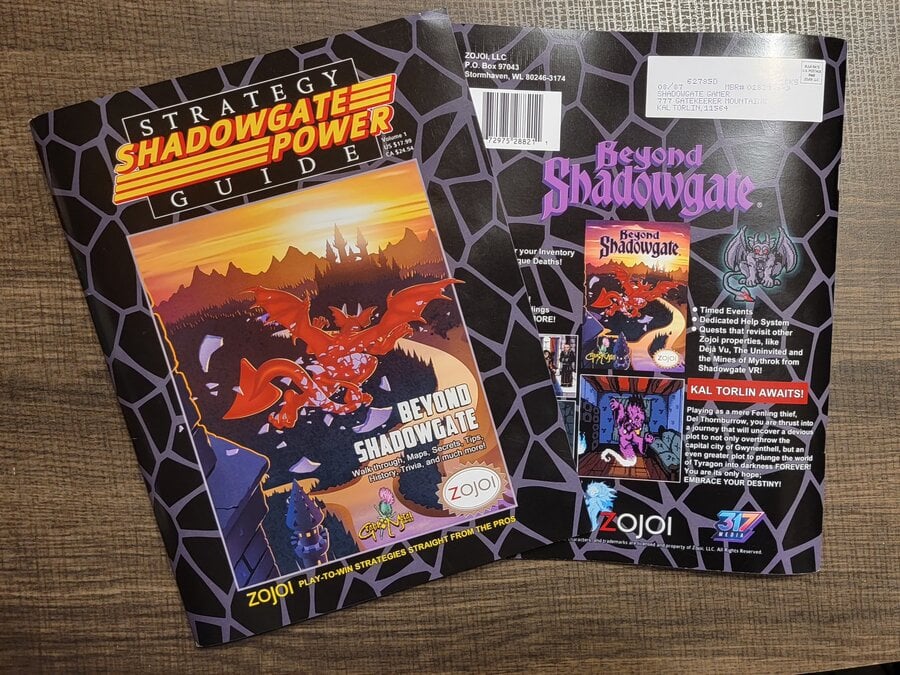
Our wish list for Beyond Shadowgate is in the tens of thousands. And I think 2% un-wishlisted it, but [many of them] are waiting for a sale and it doesn't help us make more games. This game is $17.99. It's worth more than that, but we know that there's a lot of competition out there. But players are waiting for it to be $5. And it's just hard for an indie studio to keep making money. That's just how it works.
Time Extension: Does that put more of an emphasis on the long tail than before and having to continue promoting the game for longer?
Marsh: Yeah sure, sure. We have a really active Discord and it does show you've got to do a lot more if you're going to do it. Not only are you going to have to cook the food, but you're going to have to do the dishes, right? That's a terrible analogy, sorry, but you know what I mean. It does put a lot more pressure on you.
Time Extension: In terms of Zojoi, what is next for you? Are you planning to do more with these properties that you've picked up? Or is it mostly just about supporting this release and seeing how well it does for now?
Marsh: So right now we're working on Shadowgate VR II: The Source of Magic. That will be going out on PlayStation soon. We're in testing.
We also have Shadowgate 2 coming out, which I'm licensing. My son and I have been working on the spell system and other things for that. But that's being done by a French company. That's supposed to be coming out end of the year, maybe.
We've been talking about a sequel to the board game. And then, you know, we'll continue to port the Sherlock Holmes Consulting Detective games from the 90s — the video-based ones. We still have like four or five more of those, if we get to them. But I'm 60 now. So, you know, I have to be careful about how I use my time. There's a great quote by the author Stephen Covey that says, "The main thing is to keep the main thing the main thing". You could apply it to any part of your life, but just because there's a shiny possibility off to my right doesn't mean that I should always go for it, right?
I have already mentioned we're looking at working on a design for a sequel to The Uninvited and whether or not we want to do that, because we had such a great time making the game for Beyond Shadowgate. So I think that that will continue. And then maybe we'll port this game to consoles, at least to the Switch, which I think Beyond Shadowgate would do well on.
Time Extension: Yeah, we definitely agree. Thanks for your time Dave! We appreciate it.
